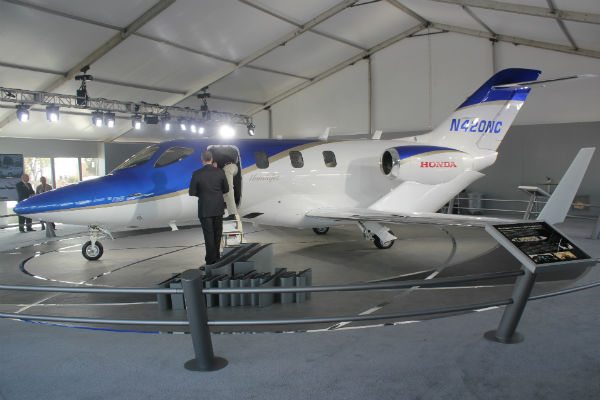HondaJet back on track for 100 aircraft each year

One of five FAA-conforming HondaJets on display at NBAA 2013.
After several setbacks, Michimasa Fujino, CEO of Honda Aircraft Company, says the first HondaJet will be delivered in 2015.
At the top of the business jet cycle there was no shortage of companies that wanted to build new business jets. They announced innovative designs, booked orders and then hit problems – usually with getting certification – bringing their aircraft programmes to an abrupt end.
The same could have been true of Michimasa Fujino’s aircraft. The aircraft has an unusual over-the-wing engine mount, a new engine and has also suffered several delays. But there is one major difference: Fujino works for Honda.
Fujino started working on the HondaJet in 1986, with the first flight on an experimental aircraft taking place in December 2003. The company started selling it at the annual NBAA convention in the US in September 2006 and planned to deliver the first aircraft in 2010.
Following delays with the joint-venture GE-Honda engine, the first aircraft is now expected to be delivered in 2015 and will cost $4.5 million to buy. No small start-up could live with a delay of five years, but it is manageable for Honda, which had earnings of $1.23 billion in the last quarter. In fact, Honda’s market value of $73 billion is greater than the combined market capitalisation of Gulfstream’s General Dynamics ($30 billion), Cessna’s Textron ($8.1 billion), Bombardier ($7.6 billion) and Embraer ($5.4 billion).
However, there is no doubt that the delays have been frustrating. “It was a big challenge that we had to overcome,” says Fujino. “Sometimes it is very difficult for the engineers to keep motivation. I have tried to motivate them by making them believe in what we are doing.”
With the company now confident that the programme is back on track, Fujino says the mood in the company has changed. “The motivation and excitement is really going now,” he adds. The company also expects sales to be boosted by Honda providing financing to US customers.
Another factor which has made Honda’s delays less frustrating is demand for light jets falling significantly from when the project was launched. “Now the light jet market is starting to stabilise, we expect it to recover in 2015, so it is very good timing for us,” says Fujino.
Honda now hopes to deliver four to five HondaJets around the time of certification and following a ramp-up period, Fujino expects the company to deliver 80-100 HondaJets every year. If the extent of the company’s ambition isn’t already clear, no manufacturer has delivered more than 80 units since Embraer delivered 100 Phenom 100s in 2010 and the only other models to reach 100 yearly deliveries since 2007 is the Cessna Mustang in 2008 and 2009.
“Generally speaking, the light jet market is not in very good condition, but at the same time, HondaJet is a little bit unique, because the concept of HondaJet is to deliver jet performance with turboprop efficiency,” says Fujino. “This is a new product to stimulate [the market]. The reason the light jet market has some stagnation is not only because of saturation, but also the attractiveness or maybe the usefulness or efficiency of each jet.”
“I’m looking at creating a market rather than looking at the current market,” he adds.









